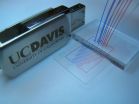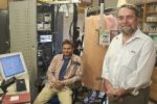(Press-News.org) PHILADELPHIA - Mimicking the reflective iridescence of a butterfly's wing, investigators at the University of Pennsylvania School of Medicine and School of Engineering and Applied Sciences have developed a color-changing patch that could be worn on soldiers' helmets and uniforms to indicate the strength of exposure to blasts from explosives in the field. Future studies aim to calibrate the color change to the intensity of exposure to provide an immediate read on the potential harm to the brain and the subsequent need for medical intervention. The findings are described in the ahead-of-print online issue of NeuroImage.
"We wanted to create a 'blast badge' that would be lightweight, durable, power-free, and perhaps most important, could be easily interpreted, even on the battlefield", says senior author Douglas H. Smith, MD, director of the Center for Brain Injury and Repair and professor of Neurosurgery at Penn. "Similar to how an opera singer can shatter glass crystal, we chose color-changing crystals that could be designed to break apart when exposed to a blast shockwave, causing a substantial color change."
D. Kacy Cullen, PhD, assistant professor of Neurosurgery, and Shu Yang, PhD, associate professor of Materials Science and Engineering, were co-authors with Smith.
Blast-induced traumatic brain injury is the "signature wound" of the current wars in Iraq and Afghanistan. However, with no objective information of relative blast exposure, soldiers with brain injury may not receive appropriate medical care and are at risk of being returned to the battlefield too soon.
"Diagnosis of mild traumatic brain injury [TBI] is challenging under most circumstances, as subtle or slowly progressive damage to brain tissue occurs in a manner undetectable by conventional imaging techniques," notes Cullen. There is also a debate as to whether mild TBI is confused with post-traumatic stress syndrome. "This emphasizes the need for an objective measure of blast exposure to ensure solders receive proper care," he says.
Sculpted by Lasers
The badges are comprised of nanoscale structures, in this case pores and columns, whose make-up preferentially reflects certain wavelengths. Lasers sculpt these tiny shapes into a plastic sheet.
Yang's group pioneered this microfabrication of three-dimensional photonic structures using holographic lithography. "We came up the idea of using three-dimensional photonic crystals as a blast injury dosimeter because of their unique structure-dependent mechanical response and colorful display," she explains. Her lab made the materials and characterized the structures before and after the blast to understand the color-change mechanism.
"It looks like layers of Swiss cheese with columns in between," explains Smith. Although very stable in the presence of heat, cold or physical impact, the nanostructures are selectively altered by blast exposure. The shockwave causes the columns to collapse and the pores to grow larger, thereby changing the material's reflective properties and outward color. The material is designed so that the extent of the color change corresponds with blast intensity.
The blast-sensitive material is added as a thin film on small round badges the size of fill-in-the-blank circles on a multiple-choice test that could be sewn onto a soldier's uniform.
In addition to use as a blast sensor for brain injury, other applications include testing blast protection of structures, vehicles and equipment for military and civilian use.
INFORMATION:
This research was funded by the Philadelphia Institute of Nanotechnology, and supported in part by the Office of Naval Research and the Air Force Office of Scientific Research.
Penn Medicine is one of the world's leading academic medical centers, dedicated to the related missions of medical education, biomedical research, and excellence in patient care. Penn Medicine consists of the University of Pennsylvania School of Medicine (founded in 1765 as the nation's first medical school) and the University of Pennsylvania Health System, which together form a $3.6 billion enterprise.
Penn's School of Medicine is currently ranked #2 in U.S. News & World Report's survey of research-oriented medical schools, and is consistently among the nation's top recipients of funding from the National Institutes of Health, with $367.2 million awarded in the 2008 fiscal year.
Penn Medicine's patient care facilities include:
The Hospital of the University of Pennsylvania – the nation's first teaching hospital, recognized as one of the nation's top 10 hospitals by U.S. News & World Report.
Penn Presbyterian Medical Center – named one of the top 100 hospitals for cardiovascular care by Thomson Reuters for six years.
Pennsylvania Hospital – the nation's first hospital, founded in 1751, nationally recognized for excellence in orthopaedics, obstetrics & gynecology, and psychiatry & behavioral health.
Additional patient care facilities and services include Penn Medicine at Rittenhouse, a Philadelphia campus offering inpatient rehabilitation and outpatient care in many specialties; as well as a primary care provider network; a faculty practice plan; home care and hospice services; and several multispecialty outpatient facilities across the Philadelphia region.
Penn Medicine is committed to improving lives and health through a variety of community-based programs and activities. In fiscal year 2009, Penn Medicine provided $733.5 million to benefit our community.
Color-changing 'blast badge' detects exposure to explosive shock waves
Penn neurosurgeons, engineers developing inexpensive, easy way to relate soldiers' exposure to possible brain injury
2010-11-30
ELSE PRESS RELEASES FROM THIS DATE:
How to avoid employee depression in a recession
2010-11-30
As employees become increasingly anxious about job security and financial worries during an economic recession, satisfaction with the job they have, commitment to their company and engagement with their work are all affected detrimentally. This trend could be self-fulfilling in that disengaged employees could have a negative impact on a company's products or services and lead to its decline which would inevitably see the company failing.
Researchers in business and management have now formulated a model of how such employee engagement can change during an economic downturn. ...
Please blow
2010-11-30
Christmas time is the time for mulled wine. And that tastes best at a Christmas market. So that market goers get home safely, the police are increasing their drink driving checks on car drivers right now. Those who are asked to blow into the device in this type of traffic check can be sure that the value the device displays after a short time is correct. This is because the "synthetic breath" - which helps to thoroughly test each newly developed evidential breath analyser in approval procedures at the Physikalisch-Technische Bundesanstalt (PTB) - can now be produced even ...
Cinnamon can replace harmful chemicals used to create nanoparticles
2010-11-30
COLUMBIA, Mo. ¬¬¬–Gold nanoparticles, tiny pieces of gold so small that they can't be seen by the naked eye, are used in electronics, healthcare products and as pharmaceuticals to fight cancer. Despite their positive uses, the process to make the nanoparticles requires dangerous and extremely toxic chemicals. While the nanotechnology industry is expected to produce large quantities of nanoparticles in the near future, researchers have been worried about the environmental impact of the global nanotechnological revolution.
Now, a study by a University of Missouri research ...
From the brain of a locust
2010-11-30
Tel Aviv - In the human brain, mechanical stress -- the amount of pressure applied to a particular area -- requires a delicate balance. Just the right force keeps neurons together and functioning as a system within the body, and proper nerve function is dependent on this tension.
Now researchers at Tel Aviv University say that mechanical stress plays an even more important role than medical science previously believed. Their research has the potential to tell us more than ever before about the form and function of neuronal systems, including the human brain. And they've ...
In Lancet: Artesunate suppositories are cost-effective intervention for severe childhood malaria
2010-11-30
Giving emergency artesunate suppositories to children with suspected severe malaria before referring them for treatment is a cost-effective intervention that can substantially improve the management of childhood malaria in remote African settings, according to a new study led by Boston University School of Public Health [BUSPH] researcher Yesim Tozan, PhD, (link to profile: http://sph.bu.edu/tozan)
The study, which appears online Nov. 29 in The Lancet , builds on previous research that found that the administration of one dose of rectal artesunate by a community health ...
Blast from the past: Jack pine genetics support a coastal glacial refugium
2010-11-30
Can a road-trip across eastern North America, ancient ice sheets, and DNA samples unlock the ancestral history of jack pine trees? Julie Godbout and colleagues from the Université Laval, Quebec, Canada, certainly hoped that driving across northeastern U.S. and Canada to collect samples from jack pine trees would shed some light on how glaciers may have impacted present-day pine genetics.
About 20,000 years ago, ice sheets covered most of the northern terrestrial surface of the continent of North America. For some boreal species this Last Glacial Maximum period may ...
A 'USB' for medical diagnosis?
2010-11-30
Biomedical engineers at UC Davis have developed a plug-in interface for the microfluidic chips that will form the basis of the next generation of compact medical devices. They hope that the "fit to flow" interface will become as ubiquitous as the USB interface for computer peripherals.
UC Davis filed a provisional patent on the invention Nov. 1. A paper describing the devices was published online Nov. 25 by the journal Lab on a Chip.
"We think there is a huge need for an interface to bridge microfluidics to electronic devices," said Tingrui Pan, assistant professor ...
Tempest in a teapot: International team of scientists describes swirling natural phenomena
2010-11-30
(Santa Barbara, Calif.) –– Scientists can use cylinders as small as teapots to study the mechanisms involved in powerful hurricanes and other swirling natural phenomena.
The earth's atmosphere and its molten outer core have one thing in common: Both contain powerful, swirling vortices. While in the atmosphere these vortices include cyclones and hurricanes, in the outer core they are essential for the formation of the earth's magnetic field. These phenomena in earth's interior and its atmosphere are both governed by the same natural mechanisms, according to experimental ...
Hormone oxytocin bolsters childhood memories of mom's affections
2010-11-30
Researchers have found that the naturally-occurring hormone and neurotransmitter oxytocin intensifies men's memories of their mother's affections during childhood. The study was published today in Proceedings of the National Academy of Sciences.
Researchers at the Seaver Autism Center for Research and Treatment at Mount Sinai School of Medicine wanted to determine whether oxytocin, a hormone and neurotransmitter that is known to regulate attachment and social memory in animals, is also involved in human attachment memories. They conducted a randomized, double-blind, ...
Caffeinated alcoholic beverages -- a growing public health problem
2010-11-30
San Diego, CA, November 30, 2010 – In the wake of multiple state bans on caffeinated alcoholic beverages (CABs) and an FDA warning to four companies to remove their products from the marketplace, an article published online today in the American Journal of Preventive Medicine delineates the scope of the public health problem and suggests areas of research that might help address it.
"Although several manufacturers of caffeinated beer have withdrawn their products from the market, there is no sign that young people have decreased the practice of combining alcohol and energy ...
LAST 30 PRESS RELEASES:
Longest observation of an active solar region
Why nail-biting, procrastination and other self-sabotaging behaviors are rooted in survival instincts
Regional variations in mechanical properties of porcine leptomeninges
Artificial empathy in therapy and healthcare: advancements in interpersonal interaction technologies
Why some brains switch gears more efficiently than others
UVA’s Jundong Li wins ICDM’S 2025 Tao Li Award for data mining, machine learning
UVA’s low-power, high-performance computer power player Mircea Stan earns National Academy of Inventors fellowship
Not playing by the rules: USU researcher explores filamentous algae dynamics in rivers
Do our body clocks influence our risk of dementia?
Anthropologists offer new evidence of bipedalism in long-debated fossil discovery
Safer receipt paper from wood
Dosage-sensitive genes suggest no whole-genome duplications in ancestral angiosperm
First ancient human herpesvirus genomes document their deep history with humans
Why Some Bacteria Survive Antibiotics and How to Stop Them - New study reveals that bacteria can survive antibiotic treatment through two fundamentally different “shutdown modes”
UCLA study links scar healing to dangerous placenta condition
CHANGE-seq-BE finds off-target changes in the genome from base editors
The Journal of Nuclear Medicine Ahead-of-Print Tip Sheet: January 2, 2026
Delayed or absent first dose of measles, mumps, and rubella vaccination
Trends in US preterm birth rates by household income and race and ethnicity
Study identifies potential biomarker linked to progression and brain inflammation in multiple sclerosis
Many mothers in Norway do not show up for postnatal check-ups
Researchers want to find out why quick clay is so unstable
Superradiant spins show teamwork at the quantum scale
Cleveland Clinic Research links tumor bacteria to immunotherapy resistance in head and neck cancer
First Editorial of 2026: Resisting AI slop
Joint ground- and space-based observations reveal Saturn-mass rogue planet
Inheritable genetic variant offers protection against blood cancer risk and progression
Pigs settled Pacific islands alongside early human voyagers
A Coral reef’s daily pulse reshapes microbes in surrounding waters
EAST Tokamak experiments exceed plasma density limit, offering new approach to fusion ignition
[Press-News.org] Color-changing 'blast badge' detects exposure to explosive shock wavesPenn neurosurgeons, engineers developing inexpensive, easy way to relate soldiers' exposure to possible brain injury





